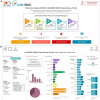FAIR in action: Brain-CODE - A neuroscience data sharing platform to accelerate brain research
- PMID: 37274750
- PMCID: PMC10233014
- DOI: 10.3389/fninf.2023.1158378
FAIR in action: Brain-CODE - A neuroscience data sharing platform to accelerate brain research
Abstract
The effective sharing of health research data within the healthcare ecosystem can have tremendous impact on the advancement of disease understanding, prevention, treatment, and monitoring. By combining and reusing health research data, increasingly rich insights can be made about patients and populations that feed back into the health system resulting in more effective best practices and better patient outcomes. To achieve the promise of a learning health system, data needs to meet the FAIR principles of findability, accessibility, interoperability, and reusability. Since the inception of the Brain-CODE platform and services in 2012, the Ontario Brain Institute (OBI) has pioneered data sharing activities aligned with FAIR principles in neuroscience. Here, we describe how Brain-CODE has operationalized data sharing according to the FAIR principles. Findable-Brain-CODE offers an interactive and itemized approach for requesters to generate data cuts of interest that align with their research questions. Accessible-Brain-CODE offers multiple data access mechanisms. These mechanisms-that distinguish between metadata access, data access within a secure computing environment on Brain-CODE and data access via export will be discussed. Interoperable-Standardization happens at the data capture level and the data release stage to allow integration with similar data elements. Reusable - Brain-CODE implements several quality assurances measures and controls to maximize data value for reusability. We will highlight the successes and challenges of a FAIR-focused neuroinformatics platform that facilitates the widespread collection and sharing of neuroscience research data for learning health systems.
Keywords: FAIR; data management; data sharing; neuroinformatics; neuroscience.
Copyright © 2023 Behan, Jeanson, Cheema, Eng, Khimji, Vaccarino, Gee, Evans, MacPhee, Dong, Shahnazari, Sparks, Martens, Lasalandra, Arnott, Strother, Javadi, Dharsee, Evans, Nylen and Mikkelsen.
Conflict of interest statement
AV, TG, SE, FM, FD, ShS, AS, EM, BL, MJ, MD, and KE were employed by Indoc Research. The remaining authors declare that the research was conducted in the absence of any commercial or financial relationships that could be construed as a potential conflict of interest.
Figures


References
-
- Behan B., Gee T., Evans S. G., Dharsee M., Evans K., Azimaee M., et al. (2020). Using A privacy preserving record linkage to facilitate an ongoing crosswalk between research and health administrative databases. Int. J. Popul. Data Sci. 5. 10.23889/ijpds.v5i5.1630 - DOI
LinkOut - more resources
Full Text Sources

